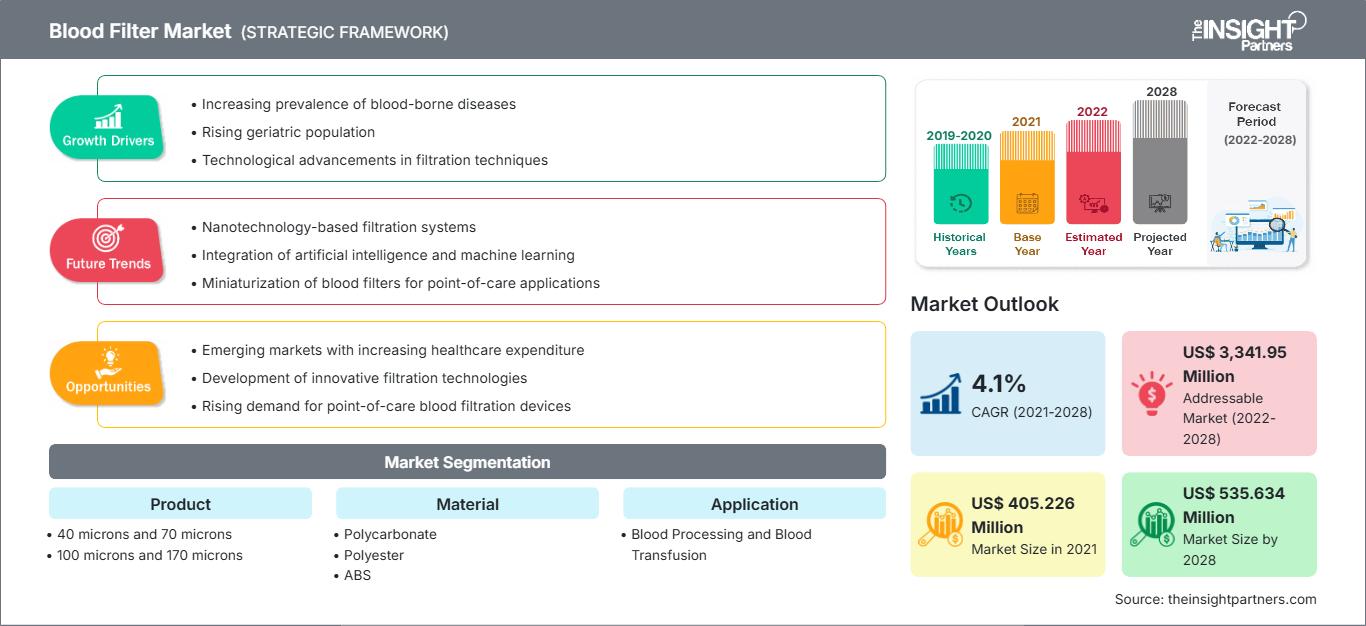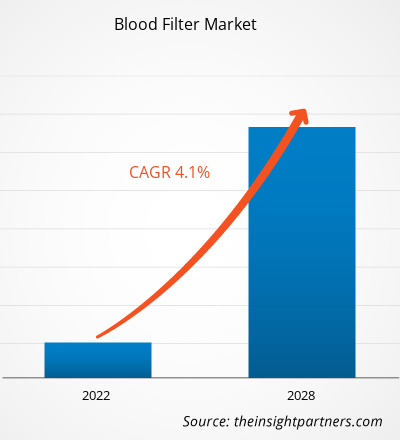혈액 필터 시장은 2021년 4억 522만 6천 달러에서 2028년 5억 3,563만 4천 달러로 성장할 것으로 예상되며, 2021년부터 2028년까지 연평균 성장률 4.1%로 성장할 것으로 예상됩니다.
혈액 필터는 폴리에스터 또는 나일론 소재의 직조 메시로 구성된 스크린형 필터로, 제품 백과 환자 사이에 위치하여 여과를 수행합니다. 이 필터는 혈류로 유입될 경우 위험할 수 있는 거대 응집물 및 혈액 성분 외 입자 물질로부터 환자를 보호하기 위해 설계되었습니다. 수혈 중 미세 응집 부위 및 피브린 응집물과 같은 거대 응집물을 제거합니다. 여과는 혈액 보관 과정에서 형성되는 백혈구, 피브린, 혈소판에서 생성되는 입자 및 거대 응집물을 포집하는 과정을 포함합니다. 만성 질환 부담 증가, 외상 및 사고 발생률 급증, 수혈 시술 건수 증가 등의 요인이 혈액 필터 시장 성장을 견인하고 있습니다. 그러나 제품 리콜은 시장 성장을 저해하고 있습니다.
요구 사항에 맞게 이 보고서를 사용자 정의하십시오.
이 보고서의 일부, 국가 수준 분석, Excel 데이터 팩을 포함하여 모든 보고서에 대한 사용자 정의를 무료로 받을 수 있을 뿐만 아니라 스타트업 및 대학을 위한 훌륭한 제안 및 할인을 이용할 수 있습니다
혈액 필터 시장: 전략적 통찰력

-
이 보고서의 주요 주요 시장 동향을 확인하세요.이 무료 샘플에는 시장 동향부터 추정 및 예측에 이르기까지 데이터 분석이 포함됩니다.
시장 분석
수혈 시술 증가로 혈액 필터 시장 성장 촉진
수혈 시술에 필요한 안전하고 충분한 혈액의 가용성을 개선하는 것은 모든 국가의 국가 의료 정책 및 인프라에 필수적인 부분이 되어야 합니다. 도시와 농촌 지역 모두에서 수혈의 필요성은 언제든 발생할 수 있습니다. 과거에는 혈액 부족으로 인해 많은 환자들이 질병으로 사망했습니다. 정기적, 자발적, 무보수 헌혈자를 위한 안정적인 시설을 확보함으로써 안전하고 충분한 혈액 공급을 확보할 수 있습니다. 또한, 이들은 혈액 매개 감염 유병률이 가장 낮기 때문에 가장 안전한 헌혈자 집단입니다.
수혈이 필요한 가장 흔한 수술에는 심혈관 시술, 제왕절개 수술, 그리고 외상이 있습니다. 미국 국립심장폐혈액연구소(National Heart, Lung, and Blood Institute)와 국립보건원(NIH)의 추산에 따르면 미국에서는 매년 500만 명이 넘는 사람들이 수혈을 필요로 합니다. 또한, 자연재해와 광범위한 사상자로 인해 전 세계적으로 수혈 수요가 증가하고 있습니다. 빈혈, 적혈구증가증, 백혈구증가증, 백혈구감소증, 혈소판증가증과 같은 혈액 질환 발생률 급증 또한 혈액 필터 시장 성장을 촉진하고 있습니다. WHO에 따르면, 지중해빈혈을 앓고 있는 대부분의 어린이는 수혈 접근성이 어렵거나 인구의 극소수에게만 제공되는 저소득 국가에서 태어납니다.
수혈 시술에 사용되는 혈액 필터는 폴리에스터 또는 나일론 소재의 직조 메시로, 제품 봉지와 환자 사이에 배치되는 스크린 형태의 필터입니다. 이러한 필터는 혈소판, 백혈구, 피브린 단백질과 같은 잠재적으로 유해한 거대 응집물과 혈액 성분 외 미립자 물질로부터 환자를 보호하도록 설계되었습니다. 대부분의 선진국에서는 정부 또는 지역 사회 기반 프로그램을 통해 수혈 필터를 제공합니다. 따라서 헌혈 및 자발적 헌혈을 위한 적합한 시설의 가용성은 수혈 시술 건수를 증가시켜 혈액 필러 시장 성장을 촉진합니다.
제품 기반 인사이트
제품을 기준으로 혈액 필터 시장은 40마이크론과 70마이크론, 100마이크론과 170마이크론, 그리고 기타 제품으로 세분화됩니다. 100마이크론과 170마이크론 부문은 2021년에 가장 큰 시장 점유율을 차지할 것으로 예상되며, 예측 기간 동안 더 높은 CAGR을 기록할 것으로 예상됩니다.
재료 기반 인사이트
혈액 필터 시장은 재료 기준으로 폴리카보네이트, 폴리에스터, ABS 등으로 세분화됩니다. 폴리에스터 부문은 2021년에 35.47%의 시장 점유율로 가장 큰 비중을 차지할 것으로 예상되며, 예측 기간 동안에도 지배적인 위치를 유지할 것으로 예상됩니다.
응용 분야 기반 인사이트
혈액 필터 시장은 응용 분야 기준으로 혈액 처리 및 수혈로 세분화됩니다. 수혈 분야는 2021년에 73.83%의 시장 점유율로 가장 큰 비중을 차지할 것으로 예상되며, 예측 기간 동안에도 지배적인 위치를 유지할 것으로 예상됩니다.
최종 사용자 기반 인사이트
혈액 필터 시장은 최종 사용자를 기준으로 혈액 은행, 병원 등으로 세분화됩니다. 혈액은행 부문은 2021년에 47.38%의 가장 큰 시장 점유율을 차지할 것으로 예상되며, 예측 기간 동안에도 이러한 지배력을 유지할 것으로 예상됩니다. 혈액 필터 시장에서 활동하는 다양한 기업들은 제품 출시, 인수합병, 협업, 제품 혁신, 제품 포트폴리오 확장 등의 전략을 채택하여 전 세계적으로 입지를 확장하고, 브랜드를 유지하며, 최종 사용자의 증가하는 수요를 충족하고 있습니다.
혈액 필터 시장
The Insight Partners의 분석가들은 예측 기간 동안 혈액 필터 시장에 영향을 미치는 지역별 동향과 요인을 면밀히 분석했습니다. 이 섹션에서는 북미, 유럽, 아시아 태평양, 중동 및 아프리카, 그리고 중남미 지역의 혈액 필터 시장 부문과 지역별 현황도 살펴봅니다.
혈액 필터 시장 보고서 범위
| 보고서 속성 | 세부 |
|---|---|
| 시장 규모 2021 | US$ 405.226 Million |
| 시장규모별 2028 | US$ 535.634 Million |
| 글로벌 CAGR (2021 - 2028) | 4.1% |
| 이전 데이터 | 2019-2020 |
| 예측 기간 | 2022-2028 |
| 다루는 세그먼트 |
By 제품
|
| 포함된 지역 및 국가 |
북미
|
| 시장 선도 기업 및 주요 회사 프로필 |
|
혈액 필터 시장 참여자 밀도: 비즈니스 역학에 미치는 영향 이해
혈액 필터 시장은 소비자 선호도 변화, 기술 발전, 그리고 제품 효능에 대한 인식 제고 등의 요인으로 인한 최종 사용자 수요 증가에 힘입어 빠르게 성장하고 있습니다. 수요가 증가함에 따라 기업들은 제품 라인업을 확장하고, 소비자 니즈를 충족하기 위한 혁신을 추진하며, 새로운 트렌드를 적극 활용하고 있으며, 이는 시장 성장을 더욱 가속화하고 있습니다.

- 을 얻으세요 혈액 필터 시장 주요 주요 플레이어 개요
제품별 혈액 필터 시장
- 40마이크론 및 70마이크론
- 100마이크론 및 170마이크론
- 기타
재료별 혈액 필터 시장
- 폴리카보네이트
- 폴리에스터
- ABS
- 기타
응용 분야별 혈액 필터 시장
- 혈액 처리
- 수혈
혈액 필터 시장 - 최종 사용자별
- 혈액 은행
- 병원
- 기타
혈액 필터 시장 – 지역별
- 북미
- 미국
- 캐나다
- 멕시코
- 유럽
- 프랑스
- 독일
- 이탈리아
- 영국
- 스페인
- 나머지 국가 유럽
- 아시아 태평양(APAC)
- 중국
- 인도
- 대한민국
- 일본
- 호주
- 나머지 아시아 태평양
- 중동 및amp; 아프리카(MEA)
- 남아프리카공화국
- 사우디아라비아
- UAE
- 중동 및 아프리카의 나머지 지역
- 남아메리카 및 중앙아메리카(SCAM)
- 브라질
- 아르헨티나
- 남아메리카 및 중앙아메리카의 나머지 지역
회사 프로필
- 아사히 카세이 주식회사
- 프레세니우스 카비 AG
- 마코파마
- 헤모네틱스 주식회사
- 인포메드 SA
- 카네카 주식회사
- 카와스미 연구소. Inc.
- Sefar AG
- Shandong Zhongbaokang Medical Implements Co., Ltd.
- Nanjing Shuangwei Biotechnology Co., Ltd.
- 과거 분석(2년), 기준 연도, CAGR을 포함한 예측(7년)
- PEST 및 SWOT 분석
- 시장 규모 가치/거래량 - 글로벌, 지역, 국가
- 산업 및 경쟁 환경
- Excel 데이터세트
최근 보고서
관련 보고서
사용 후기
구매 이유
- 정보에 기반한 의사 결정
- 시장 역학 이해
- 경쟁 분석
- 고객 인사이트
- 시장 예측
- 위험 완화
- 전략 기획
- 투자 타당성 분석
- 신흥 시장 파악
- 마케팅 전략 강화
- 운영 효율성 향상
- 규제 동향에 발맞춰 대응






















 무료 샘플 받기 - 혈액 필터 시장
무료 샘플 받기 - 혈액 필터 시장